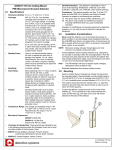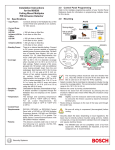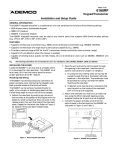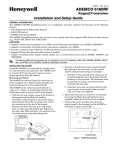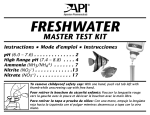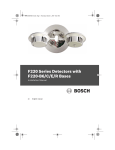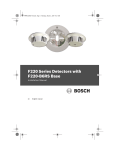Download Bosch DS9370 Specifications
Transcript
DS9370-BEL Installation Instructions EN TriTech Ceiling Mount PIR/Microwave Intrusion Detector DS9370-BEL | Installation Instructions | 1.0 1.0 Installation Considerations Installation Considerations • Not suitable for outdoor use. • Never install the detector where the passive infrared (PIR) or microwave is in constant alarm (LED on). The LED is off when properly installed. • Point away from outside traffic. Microwave energy passes through non-metallic walls. • Point away from direct and indirect sunlight. • Point away from glass or other objects that rapidly change temperature. • Point away from rotating machines such as fans. • Mount the detector on a solid and vibration-free surface. Secure drop-ceiling tiles if the area above the tiles is used as an air return for heating, ventilating, and air conditioning (HVAC) systems. • Figure 2: Opening the DS9370-BEL 1 2 1 - Arrow 2 - Recess between cover and base Figure 3: Cover Release Tabs Avoid mounting the detector within 30 cm of any fluorescent light fixtures. 2.0 1. Mounting 1 Select a mounting location where an intruder is most likely to cross the coverage pattern (Figure 1). 1 Figure 1: Coverage Patterns 1 - Release tabs (2) 4. Insert wiring into the rear of the base and through the center hole or wire entrance for surface mounting (refer to Items 1 and 2 in Figure 4 on page 3). Do not mount the detector to removable ceiling tiles unless a sandwich is made of the base, ceiling tile, and a back plate behind the tile. 2. Mount the detector between 3,7 m and 7,6 m above the floor. 3. To open the detector, locate the arrow on the detector’s cover (Item 1 in Figure 2). Insert a flat head screwdriver in the recess between the cover and the base and turn (Item 2 in Figure 2). One side of the cover remains attached to the base of the detector. Optional: Remove the cover from the base. Press the two cover release tabs while lifting the cover from the base (Figure 3). Ensure all wiring is unpowered before inserting wire. 2 5. Firmly mount the base using the mounting holes (refer to Items 3 and 4 in Figure 4 on page 3) and one of the following options: a. Depending on local regulations, mount the base directly on the surface using anchors, mollies, or wing nuts. b. Mount the detector on an electrical box. c. Connect the detector directly to short lengths of 1,27 cm conduit (short enough to avoid detector movement). 6. Use the curved mounting slots (refer to Item 4 in Figure 4 on page 3) to rotate the detector up to 60° to achieve the needed coverage. Bosch Security Systems, Inc. | 3/11 | 4998141226-02 DS9370-BEL | Installation Instructions | 4.0 4.0 Figure 4: Mounting the Base Wiring Wiring Apply power only after all connections are made and inspected. Do not coil excess wiring inside detector. 3 5 If necessary, connect the alarm and tamper contacts to a safe extra low voltage (SELV) circuit only. 6 6 4 4 Refer to Figure 6 for terminal identification. 3 1 Figure 6: Terminals - + - + 2 1 2 3 4 5 6 7. - Wire entrance or conduit base mounting hole Wire entrance for surface mounting (2) Straight mounting holes (2) Curved mounting slots (2) Tamper post Cable ties (2) To use the ceiling tamper, loosen the tamper post (Item 5 in Figure 4) by cutting the three tabs and mount the post to the ceiling using a 0,42 cm screw (Figure 5). Figure 5: Mounting the Post to the Ceiling NO C NC T T M 1 2 3 4 5 6 7 8 Terminals 1 (-) and 2 (+): Power limits are 9 VDC to 15 VDC. Use no smaller than 0,8 mm wire pair between the unit and power source. Terminals 3 (NO), 4 (C), and 5 (NC): Alarm relay contacts rated at 125 mA, 28 VDC maximum for DC resistive loads. Use Terminals 4 and 5 for the normally-closed circuits. Do not use these terminals with capacitive or inductive loads. Terminals 6 (T) and 7 (T): Normally-closed tamper contacts rated at 28 VDC, 125 mA. Terminal 8 (M): Memory Mode requires activating a supply voltage on Terminal 8. Refer to Section 8.0 Memory, Day Mode, Night Mode, and Remote Walk Test on page 5 for operating and wiring information. 1 2 1 - Tab (3) 2 - 0,42 cm screw (not included) 8. Attach the cover, if removed, and close it. 9. Use the cable ties (Item 6 in Figure 4) for strain relief. Bosch Security Systems, Inc. | 3/11 | 4998141226-02 3 DS9370-BEL | Installation Instructions | 5.0 5.0 LED Operation LED Operation 6.0 Walk Test 1: Ensure the LED jumper is set to ON (refer to Item 2 Figure 7). 2: To avoid false alarm, set the microwave range to its minimum setting before starting the Walk Test (refer to Item 3 in Figure 7). 3: After removing or replacing the cover, wait 1 min for the detector’s microwave to settle. Wait at least 5 sec between the walk testing procedures. The DS9370-BEL uses a tri-color LED to indicate alarm and supervision trouble conditions (Table 1). Table 1: LED Trouble Conditions LED Steady red Steady yellow Steady green Flashing red Cause Unit alarm Microwave activation (Walk Test) PIR activation (Walk Test) Warm-up period after power up Refer to Table 2 for the LED operations and to Table 3 for the PIR sensitivity selections. Table 2: LED Operations Feature LED ON/OFF Pins (refer to Figure 7) Setting ON OFF Description Operates the tri-color LED. If LED indication is not wanted after setup and the Walk Tests are complete, place in the OFF position. No jumper across the On or Off pins disables the LED. PIR Sensitivity Selection Setting Description Use this setting if more sensitivity is needed. Recommended setting for most installations. Tolerates environmental extremes. LOW** Wait at least 2 min after power up to start the Walk Test. The red LED flashes until the detector stabilizes and no movement is detected for 2 sec. Table 3: HI* 1. * More sensitive to environmental changes that can cause false alarms. ** The detector is shipped in Low Sensitivity Mode. 2. Watch the LED as you walk towards the edge of the pattern (refer to Figure 1 on page 2). The LED lights at the outside edge of the coverage range. Refer to Table 4 for the LED indicators. Table 4: LED Green Yellow Red LED Lights Lights to Identify PIR pattern. the microwave pattern. Microwave and PIR Modes 3. Repeat Step 2 from different directions until you adequately verify the coverage pattern. 4. If the required microwave coverage is not achieved, increase the microwave adjustment by slightly turning it clockwise (Item 3 in Figure 7). 5. Wait 1 min after adjusting the microwave range before continuing the Walk Test. Refer to Figure 7 Figure 7: LED ON and OFF Pins and PIR Sensitivity Selection Pins Do not adjust the microwave range higher than needed. 1 HI 7.0 2 • Microwave: The complete circuit operation of this subsystem is checked approximately every 4 h. • Default: The detector defaults to PIR protection if the microwave subsystem fails. The detector indicates an alarm using the green LED only and by activating the alarm relay. LOW ON 3 OFF MAX 1 - PIR sensitivity 2 - LED ON and OFF 4 Supervision PIR Signal Gain 3 - Microwave Bosch Security Systems, Inc. | 3/11 | 4998141226-02 DS9370-BEL | Installation Instructions | 8.0 8.0 Memory, Day Mode, Night Mode, and Remote Walk Test The Memory, Day Mode, Night Mode, and Remote Walk Test require a supply voltage on Terminal M to activate. The supply voltage must range from 6 VDC to 18 VDC. Use the switch (Figure 8) or an external power supply (Figure 9). Figure 8: Sample Switch - + - + NO C NC T T M Memory, Day Mode, Night Mode, and Remote Walk Test Refer to Table 4 for the desired action, control voltage, and LED jumper position. Table 5: Tests Desired Action Turn on Night Mode Turn off Night Mode/Display Stored Alarm To RESET Stored Alarm Turn on Remote Walk Test, if off 2 Turn off Remote Walk Test, if on 1 1 - Power 2 - Memory 8.2 Figure 9: External Power Supply 1 - Control Voltage (Terminal M) ON (for more than 20 sec) OFF (from Night Mode) LED Jumper ON ON (for more than 5 sec to enter Night Mode) ON (for more than 5 sec but less than 20 sec) ON (for more than 1 sec but less than 20 sec) ON ON OFF OFF Anti-Vandal Screw After the cover is closed, secure the entire assembly using the supplied anti-vandal screw (Figure 10). + Figure 10: Anti-vandal Screw - + - + NO C NC T T M 3 2 1 - Control panel or external DC supply 2 - Power 3 - Memory • Control Voltage: +6 VDC to +18 VDC = ON (Switch Closed); 0 VDC = OFF (Switch Open) 1 1 - Anti-vandal screw • Day Mode: Disables the alarm memory and allows the LED (if activated) to operate normally. 8.3 • Memory: Activated when the DS9370-BEL is in the Night Mode. This allows the detector to store an alarm for display at a later time. Memory Mode requires the LED jumper to be in the ON position. At least once each year, verify the detector’s range and coverage. For continuous daily operation, instruct the end user to walk through the far end of the coverage pattern to verify alarm output before arming the system. • Night Mode: Enables the alarm memory and disables the LED operation. • Remote Walk Test: Remotely enables LED operation from Terminal M for walk testing. This feature is used when LED operation is disabled; the LED jumper in the OFF position. Bosch Security Systems, Inc. | 3/11 | 4998141226-02 Maintenance 5 DS9370-BEL | Installation Instructions | 9.0 9.0 Coverage Pattern Coverage Pattern Figure 13: Coverage Pattern Masking Figure 11 shows the typical coverage pattern for 3,7 m mounting height with optical adjustments set to "I." The maximum range is available between lens centers, not directly in front of the lens as might be expected. 1 1 Figure 11: Coverage Areas 1 2 2 3 14 13 3 12 11 10 9 8 7 6 5 4 3 2 2 1 1 0 1 2 1 3 2 1 2 3 4 5 2 3 3 6 7 8 9 10 11 12 13 14 14 13 12 11 10 9 8 1 - 120° mask 7 6 5 4 3 2 1 0 1 2 3 4 5 6 7 Meters 1 2 2 - 90° mask 8 9 10 11 12 13 14 Figure 14: PIR Zones 3 4 1 1 - PIR Area 1 2 - PIR Area 2 9.1 3 - PIR Area 3 4 - Microwave Coverage Pattern Masking Mask undesired areas with the supplied set of masks. The masking kit contains two 120° masks and two 90° masks designed for the outside of the detector. Place the masks on the outside of the detector (Figure 12). Figure 12: Masking Kit 2 MAX 1 2 - 1 - 120° mask 2 - 90° mask Use the supplied masks to mask 90°, 120°, 180°, 210° 240°, or 330°. Figure 13 shows two examples of coverage pattern masking. 10.0 Adjusting the Optical Module The DS9370-BEL PIR zones are divided into three groups. You can independently adjust each group vertically for the best coverage within a room (Figure 14). 6 PIR Signal Gain + NO C NC T T M 1 - Only two coverage patterns are shown for clarity. 2 - PIR vertical adjustment knobs (3) Figure 15 on page 7 shows a sample of the chart located on the DS9370-BEL. Use this chart to adjust optical modules based on the detector’s mounting height. The range shown is the distance from the detector to the outside edge of the coverage pattern. In installations where targeted coverage is required for part of the area, the optical modules must be adjusted for the correct coverage. In Figure 16 on page 7, the Bosch Security Systems, Inc. | 3/11 | 4998141226-02 DS9370-BEL | Installation Instructions | 11.0 Specifications Figure 15: Optical Module Adjustments AXIMUM RANGE FEET (METERS) MOUNTING HEIGHT FEET (METERS) 8 (2,4) 10 (3) 14 16 12 18 20 22 24 25 15 (3,7) (4,3) (4,6) (4,9) (5,5) (6,1) (6,7) (7,3) (7,6) 10 (3) C A 15 (4,6) G D A A 20 (6,1) I G D B A A I F E D C A A 30 (9,1) H F E E C B A 35 (10,7) I G G F E C B 25 (7,6) A A detector is mounted 3,7 m above the floor. The distance to one wall is 6,1 m and 10,7 m to the opposite wall. Using Figure 15 the optical module for the 6,1 m range was set to “D” and the optical module for the 10,7 m was set to “I.” Figure 16: Optical Module Adjustment Sample (6,1 m) (10,7 m) (3,7 m) For clarity, only two coverage patterns are shown. 11.0 Specifications Table 5: Specifications Dimensions (H x D) Coverage Input Power Standby Power Alarm Relay Microwave Frequency 8.9 cm x 17.8 cm Covers 360° by 15,8 m to 21 m diameter when mounted on 3,7 m to 7,6 m high ceilings. Covers a 12 m area when mounted at 2,4 m and covers a 15 m area when mounted at 3 m. The pattern has 69 zones grouped into three sets of 23 zones each. Each set covers 1/3 of the 360° coverage pattern and has a vertical adjustment for precise pattern alignment. 0 VDC to 15.0 VDC; 19 mA standby, 39 mA in alarm with LEDs enabled, and 39 mA maximum current. Only use a listed limited power source. No internal standby battery. 29 mAh required for each hour of standby time needed. Standby power must be provided by a listed limited power source. Low and high settings. -operating Form “C” relay. Contacts rated 125 mA, 28 VDC, 3 W maximum for DC resistive loads. The contacts transfer on alarm for a period of 4 sec. Some countries require the relay to be connected to a SELV circuit only. Do not use with capacitive or inductive loads. Normally-closed (with cover in place) tamper switch. A wall (base) tamper is included. Contacts are rated at 28 VDC, 125 mA, 3 W maximum. Some countries require the switch to be connected to a SELV circuit only. Connect the tamper circuit to a 24-hour protection circuit. Storage and operating range is -40°C to +49°C. BEL 10,525 GHz Belgium Intended Use Bosch Security Systems, Inc. | 3/11 | 4998141226-02 7 Bosch Security Systems, Inc. 130 Perinton Parkway Fairport, NY 14450 www.boschsecurity.com © Bosch Security Systems, Inc. 2011








